图书介绍
二语写作文本产出机制研究【2025|PDF下载-Epub版本|mobi电子书|kindle百度云盘下载】

- 王俊菊,闫秋燕著 著
- 出版社: 济南:山东人民出版社
- ISBN:9787209103367
- 出版时间:2017
- 标注页数:275页
- 文件大小:26MB
- 文件页数:295页
- 主题词:第二语言-写作-研究
PDF下载
下载说明
二语写作文本产出机制研究PDF格式电子书版下载
下载的文件为RAR压缩包。需要使用解压软件进行解压得到PDF格式图书。建议使用BT下载工具Free Download Manager进行下载,简称FDM(免费,没有广告,支持多平台)。本站资源全部打包为BT种子。所以需要使用专业的BT下载软件进行下载。如BitComet qBittorrent uTorrent等BT下载工具。迅雷目前由于本站不是热门资源。不推荐使用!后期资源热门了。安装了迅雷也可以迅雷进行下载!
(文件页数 要大于 标注页数,上中下等多册电子书除外)
注意:本站所有压缩包均有解压码: 点击下载压缩包解压工具
图书目录
Chapter One Overview of the Study1
1.1 Introduction1
1.2 Developments in Studies on L1 Writing3
1.3 Developments in Studies on L2 Writing4
1.4 Statement of Problems5
1.5 Method and Purpose of the Study6
1.6 Structure of the Book7
Chapter Two Theoretical Orientations to Writing Processes9
2.1 Introduction9
2.2 Cognitive Models of the Writing Process9
2.3 Socio-cognitive Models of the Writing Process15
2.4 Sociocultural Theory and the Writing Process20
2.5 Activity Theory and the Writing Process22
2.6 Chapter Summary24
Chapter Three Previous Studies on EFL Writing Processes26
3.1 Introduction26
3.2 Studies on Planning Processes26
3.2.1 Nature of Planning Processes27
3.2.2 Types of Planning Processes29
3.2.3 Factors Influencing Planning Processes29
3.2.4 Effects of Planning Processes on Writing Performance31
3.3 Studies on Generating Processes34
3.3.1 Language Choices in Generating Processes34
3.3.2 Focus of Ideas in Generating Processes36
3.3.3 Role of Proficiency Level in Generating Processes38
3.3.4 Writing Tools and Generating Processes39
3.4 Studies on Revising Processes42
3.4.1 Nature of Revision in Writing Processes42
3.4.2 Variations in Revising Behaviors43
3.4.3 Strategies Used in Revising Processes45
3.5 Chinese Studies on EFL Writing Processes46
3.6 Research Gaps and Research Objectives48
3.7 Chapter Summary49
Chapter Four Methodology of the Study50
4.1 Introduction50
4.2 Think-aloud Protocols50
4.3 Stimulated Recalls54
4.4 Computer-aided Methods55
4.4.1 Keystroke Logging55
4.4.2 Inputlog56
4.4.3 Automated Essay Scoring57
4.5 Chapter Summary59
Chapter Five Planning in the Text-producing Processes60
5.1 Introduction60
5.2 Design of the Study61
5.2.1 Participants61
5.2.2 Sources of Data63
5.2.3 Data Collection63
5.2.4 Data Analysis65
5.3 Results and Findings66
5.3.1 Overall Temporal Features of Planning Processes66
5.3.2 Temporal Features of Planning Processes by Writing Tool72
5.3.3 Temporal Features of Planning Processes by Group78
5.4 Discussion82
5.4.1 Shared Features of Planning Time Allocation82
5.4.2 Balanced Planning Time of More Proficient Students84
5.4.3 Decreases in Pre-writing Planning Time86
5.5 Chapter Summary87
Chapter Six Generating in the Text-producing Processes88
6.1 Introduction88
6.2 Design of the Study90
6.2.1 Participants90
6.2.2 Sources of Data90
6.2.3 Data Collection91
6.2.4 Data Analysis93
6.3 Results and Findings95
6.3.1 Overall Features of Generating Processes95
6.3.2 Features of Generating Processes by Group99
6.3.3 Features of Generating Processes by Writing Tool102
6.4 Discussion103
6.4.1 Large Time Proportion of Generating Processes103
6.4.2 Common Use of L1 in L2 Generating Processes104
6.4.3 Reduction of Generating Time in Keyboard Writing105
6.5 Chapter Summary106
Chapter Seven Revising in the Text-producing Processes107
7.1 Introduction107
7.2 Design of the Study109
7.2.1 Participants109
7.2.2 Sources of Data109
7.2.3 Data Collection110
7.2.4 Data Analysis111
7.3 Results and Discussion112
7.3.1 Features of Online Revising Processes112
7.3.2 Types of Online Revisions116
7.3.3 Focuses of Online Revising Processes118
7.4 Chapter Summary119
Chapter Eight Apprehension in the Text-producing Processes121
8.1 Introduction121
8.2 Design of the Study122
8.2.1 Participants122
8.2.2 Sources of Data123
8.2.3 Data Collection125
8.2.4 Data Analysis128
8.3 Results and Discussion130
8.3.1 Overall Situation of Writing Apprehension130
8.3.2 Sources of Writing Apprehension141
8.3.3 Possible Ways to Reduce Writing Apprehension145
8.4 Chapter Summary146
Chapter Nine Reader Awareness in the Text-producing Processes148
9.1 Introduction148
9.2 Design of the Study149
9.2.1 Participants149
9.2.2 Sources of Data150
9.2.3 Pilot Study152
9.2.4 Data Collection152
9.2.5 Data Analysis154
9.3 Results and Discussion156
9.3.1 Perceptions of Audience Awareness in Writing156
9.3.2 Target Audience in Students'Mind164
9.3.3 Ways to Realize Audience Awareness167
9.4 Chapter Summary178
Chapter Ten Thinking Medium in the Text-producing Processes179
10.1 Introduction179
10.2 Design of the Study180
10.2.1 Participants180
10.2.2 Sources of Data181
10.2.3 Data Collection183
10.2.4 Data Analysis186
10.3 Results and Discussion190
10.3.1 Alternate Use of L1 and L2 as Medium of Thought190
10.3.2 Situations Triggering the Shift of Thinking Medium196
10.3.3 Task Types and the Use of Thinking Medium202
10.3.4 Effect Factors to the Choice of Thinking Medium203
10.3.5 Relationship between L1 Use and Writing Performance208
10.4 Chapter Summary209
Chapter Eleven Toward a Mechanism of Text Production in L2 Writing210
11.1 Introduction210
11.2 The Role of Proficiency Level210
11.3 The Role of Thinking Language212
11.4 The Role of Writing Tools213
11.5 The Role of Task Type215
11.6 The Role of Reader Awareness216
11.7 The Role of Writing Apprehension217
11.8 A Tentative Model of L2 Text Production219
11.9 Chapter Summary222
Chapter Twelve Conclusion223
12.1 Summary of the Study223
12.2 Pedagogical Implications225
12.2.1 Teaching Writing beyond Language Points225
12.2.2 Teaching Writing with the Aid of Technology226
12.2.3 Combining Reading and Writing in Writing Instruction227
12.2.4 Providing Adequate Opportunities for Practice227
12.3 Limitations of the Study227
12.4 Suggestions for Future Studies228
12.5 Concluding Remarks229
References230
Appendix 1261
Appendix 2262
Appendix 3263
Appendix 4264
Appendix 5265
Appendix 6266
Appendix 7269
Appendix 8270
Appendix 9271
Appendix 10272
Acknowledgements274
热门推荐
- 75128.html
- 2149329.html
- 458416.html
- 3670356.html
- 2154169.html
- 1118373.html
- 3471526.html
- 1519694.html
- 2623379.html
- 3378374.html
- http://www.ickdjs.cc/book_3735019.html
- http://www.ickdjs.cc/book_1154323.html
- http://www.ickdjs.cc/book_2012275.html
- http://www.ickdjs.cc/book_38993.html
- http://www.ickdjs.cc/book_713142.html
- http://www.ickdjs.cc/book_1774631.html
- http://www.ickdjs.cc/book_857802.html
- http://www.ickdjs.cc/book_548340.html
- http://www.ickdjs.cc/book_1941427.html
- http://www.ickdjs.cc/book_3752348.html